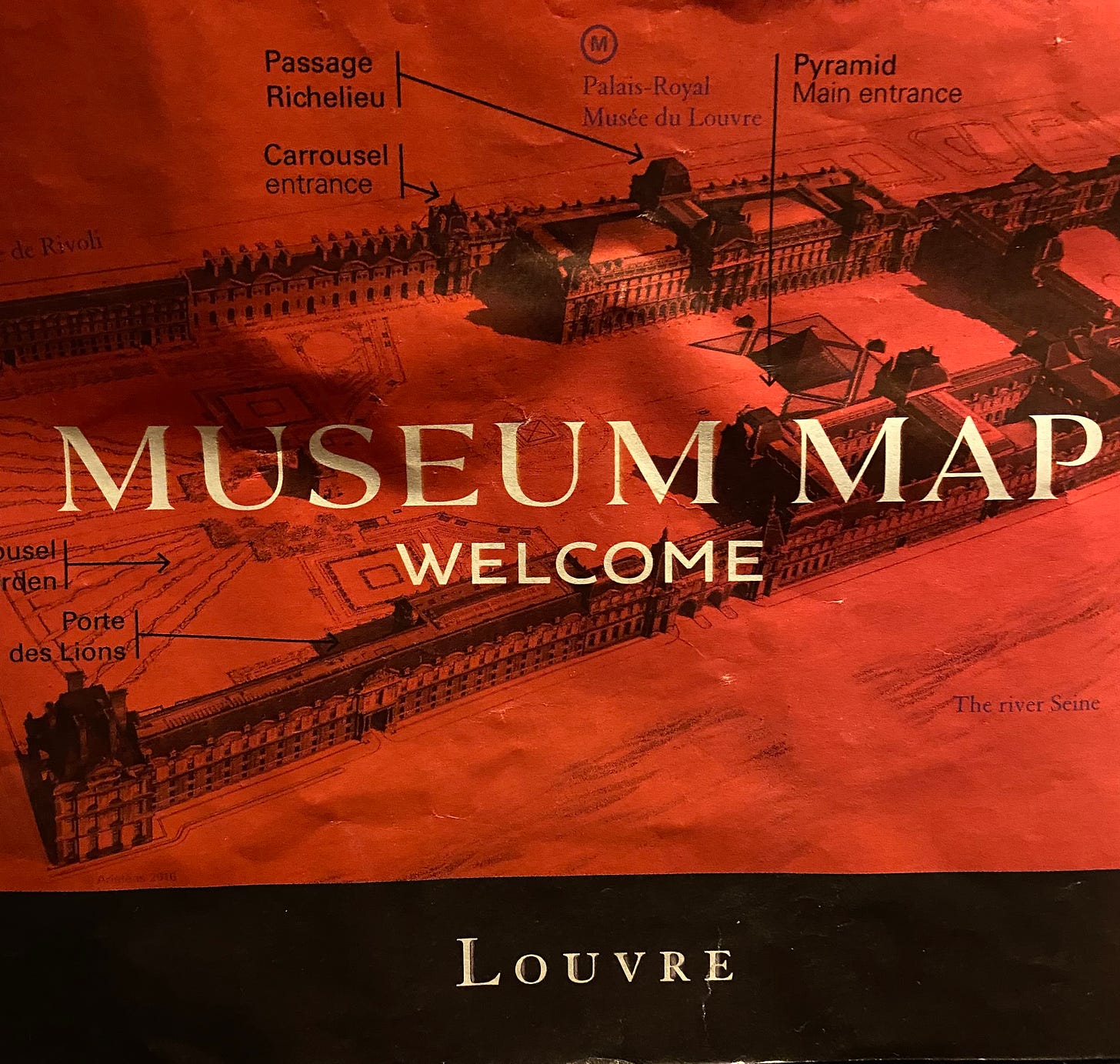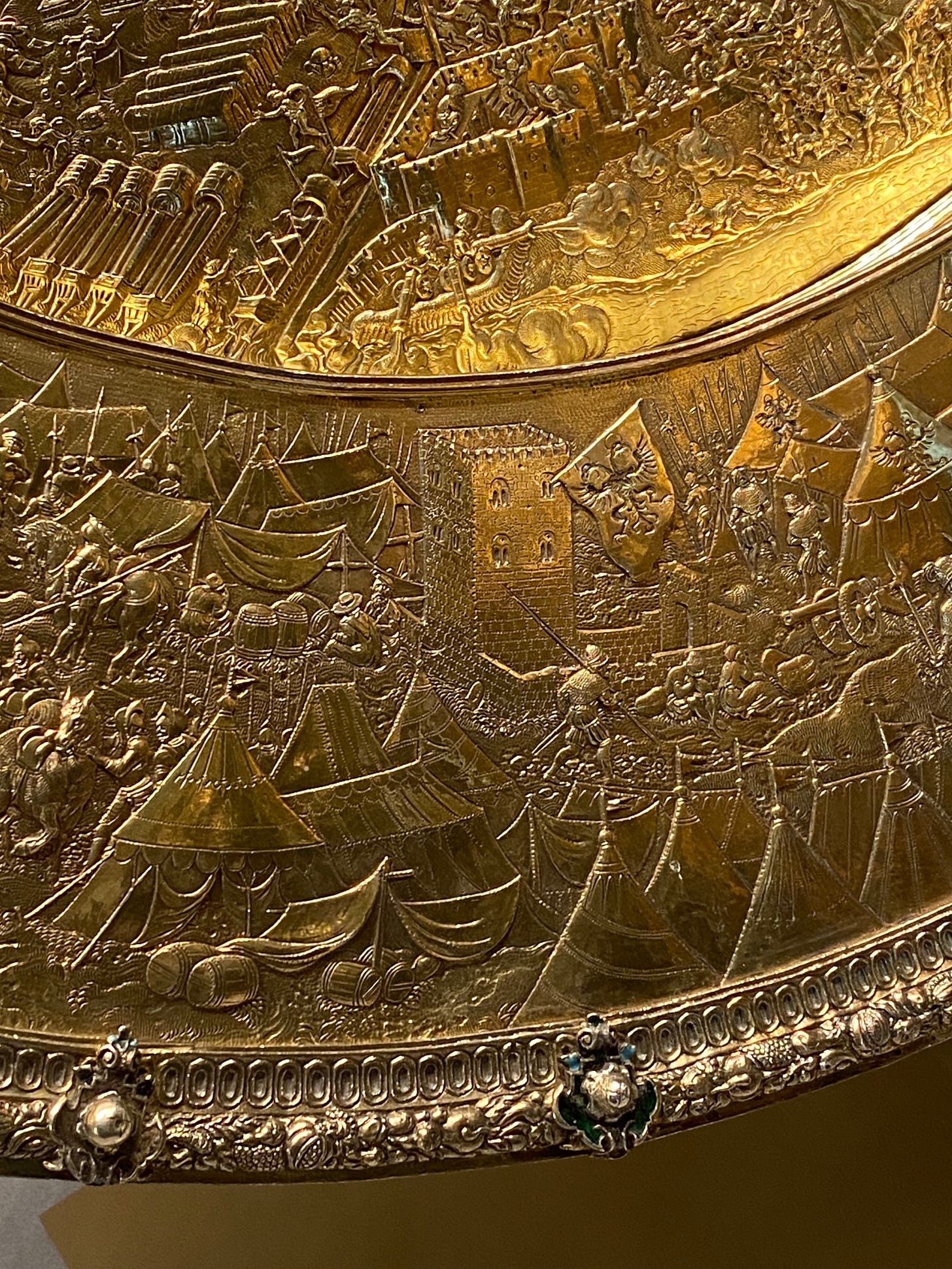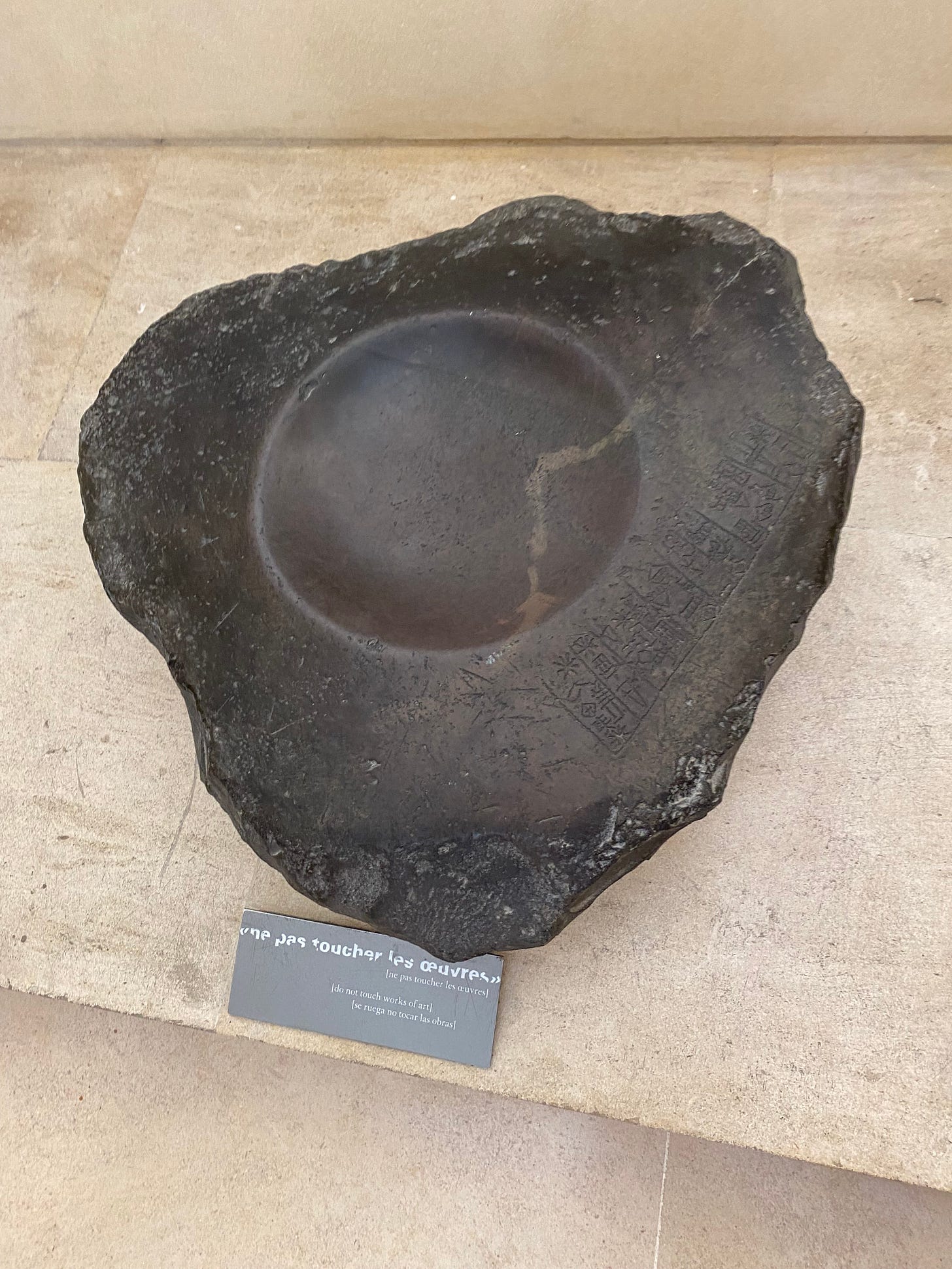More Paris
Codes, amulets, pharaohs and mistresses: peering back in time, taking what you can get — and the first part of a day at the Louvre.
The thing about the Louvre, or any good museum, is that it’s just like a mountain: you climb it a slightly different way each time.
I’ve been to the Louvre before but, every time I go, I see different things. No two people arriving there follow the same path nor see the same things.
They give you a map but you can’t just follow a map through the Louvre. You have to give up any hope of a plan and go where your curiosity takes you. Interest yourself in what passes before you. Take turns that feel right. Near East? Decorative arts? Northern Europe? Sure! Nothing is uninteresting.
If I tell you the things I thought worth seeing the other day in the Louvre, you might not agree, or you might (probably would) find something else equally (or more) interesting and provocative. In each piece, is a world that is mostly lost but still offers up some truth of itself.
The engraving on a gold plate gives a detailed glimpse of a 15th century Italian war camp: barrels, tents, stacks of hay. Soldiers asleep with folded arms; others tending horses under a line of crenellated battlements.
A person sat and etched this. Were they cold, hot? Tired, short-sighted, hungry? Art is truth, and the art in the Louvre speaks to me of the true way things used to be. It offers glimpses of lost worlds from other’s eyes; it speaks of forgotten griefs and the weight of all those who have gone before.
I am reminded of one of my favourite poems.
Here I am again on the Eurostar. This time, to collect my son, who has spent a week with family in Paris. (And spoiler: no Killian Sundermann on the street this time, more’s the pity).
The Eurostar is a violence. It flings you out of London at 147mph, a bullet fired out the barrel of tunnels beneath east London, into the sunshine salt flats past City Airport and Rainham steel works. There, puddles of estuarine silver chequerboard the flats. Motorways arch above and below, cutting gorges in the chalk, and the train weaves too quickly around pylons, rubbish piles and overpasses; under cranes, container ships and lines of geese.
The estuary presents the rubbish of earlier ages for picking. The train picks up speed at Tilbury, the place to go for mudlark hunting of old Codd-neck bottles, Victorian dolls and pottery sherds. Surely this is some mistake, we’re going too fast. Substations, dirt bike tracks, winding streams and decaying boats — then, incongruous, the pretty promontory of Rochester flashes past, a great Dickensian lump presiding over the marshes.
There are razor wire fences here too, of the kind that conjure images of torn flesh and flaying leg muscles. These proliferate as we near the entrance of the tunnel to Europe.
This isn’t a corner of the country I enjoy. I know it’s rather trendy these days but Kent to me has always felt very far away and going in the wrong direction: an area that is passed over, like a truck stop. A way station to somewhere else.
A guy squeezes in the turnstile behind me going into the Metro on the other side. He gives a conspiratorial and pleading look and I quell my disapproval. What must it be like to struggle to buy a Metro ticket.
In Paris, evidence of the wet summer abounds. There are tubs in the station catching drips, inexplicably packed with astroturf, which gives them the look of bursting into bloom in the unseasonal damp.
When I arrived at my sister’s, my son exploded into the living room brandishing his passport.
“Grandma left this on the kitchen table for you.”
“Ok, put it on my bed.”
Then my sister and I drank a bottle of wine and I fell into a wine-snooze atop the bedclothes.
A bit of a panic the next evening.
“Where’s his passport?”
Rummaging through bag, sheets, piles of clothes deposited at some stage from bed to floor. It’s not there.
“Do you know where his passport is?”
My sister’s partner remembers. “Your mom left it on the table.”
“It’s not there. He put it on my bed. But it’s not there either.”
He’s asleep, I can’t ask him. I close my eyes and take a moment. If I was my eight year old son, what would I have done with it?
And then I know.
I lift my pillow.
And there it is.
He’s posted it to me from yesterday, like the tooth fairy, under my pillow. It sparkles with a little magic as I uncover it.
The next morning he pulls up four plastic animal figurines after a rummage in a charity shop. A unicorn, stegosaurus, alligator and stag: one for each of the kids.
My sister turns one in her hand.
“They’ll last longer than any of us.”
Things last a long time in Paris; even longer in a museum. Tacked to walls across Paris are placards marking spots of historical interest — all in French so I often can’t be bothered to puzzle them out, though they usually look interesting.
I passed one that mentioned Les Lampiers — the lamplighters — and thought of all the little missives we send out online, lighting cones of brightness in the depthless black. I wonder how long their light will last.
Trekking through the Louvre, little lamps shine everywhere. Any lit tunnel you choose to peer down will reveal an unknown world.
Unexpected treasures will be discovered, as from a charity shop or underneath a pillow.
Here are the worlds that were incrementally more revealed to me after a visit to the Louvre.
These Assyrian inlay figures cut from large mother-of-pearl shells would have been mounted and strung together into different scenes. They appeal to me as story-telling tools, like puppets, or paper dolls. There are even odd pieces of spare costumery — jackets and cloaks — to dress up the different characters. Like the faces on a Where’s Wally page, these little figures are individuals; they have personality, still fresh across millennia.
I saw this basalt column in a fairly quiet gallery. No one was looking at it. I would have walked past it myself but something about its size — over 7 feet high with two carved figures at the top and these dense markings all over it — called me over.
When I saw the label, I got very excited.
“This is a big deal,” I told my son. “This is Hammurabi’s code, the first recorded legal system.”
As soon as I said it (possibly too loudly), twenty to thirty people swarmed us, surrounding the column, and started taking pictures of it with great enthusiasm.
We had to retreat. But not before I took this picture of the first “if X then Y” codex — “If so-and-so breaks your arm, you may break his” — and the inception of eye-for-an-eye justice.
That gold plate I mentioned of a battle camp? Here it is. Can you see the face in the centre, between the two crosses, looking straight at us? Capped, bearded, looking right out from five hundred years ago. I imagine it’s a self-portrait of the artist, tired, hungry and unsure of his salvation; an onlooker amidst so much horror.
This mysterious object was labelled as a “crapaudine” in French. Allow me to share that I spent a not-inconsiderable amount of time trundling down rabbit-holes on Google, chasing that word down. It translates directly as “toad”, which was intriguing but unhelpful. Wikipedia redirected to something I’d never heard of called a toadstone, which crops up in As You Like It and the writings of Pliny the Elder and used to be worn as an amulet in medieval times. A mythical stone believed to be cut from the brain of a living toad, but actually: the fossilised teeth of a pre-historic flatfish.
Anyway, this chunky item has nothing to do with toads or teeth.
Keep reading with a 7-day free trial
Subscribe to Life Litter to keep reading this post and get 7 days of free access to the full post archives.









